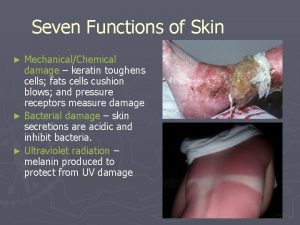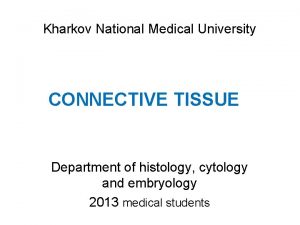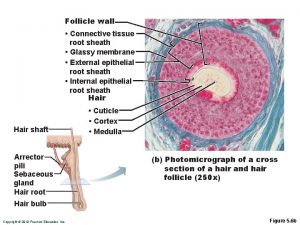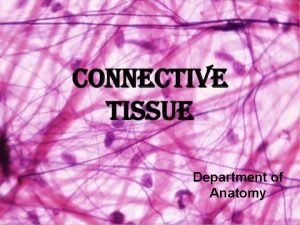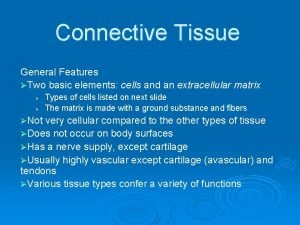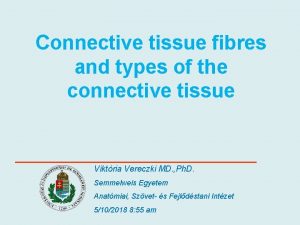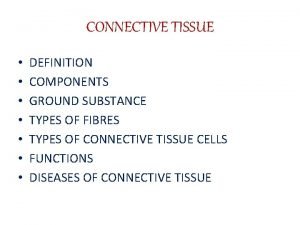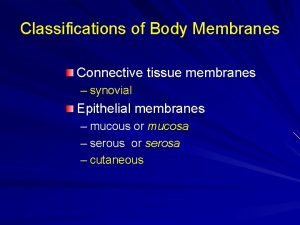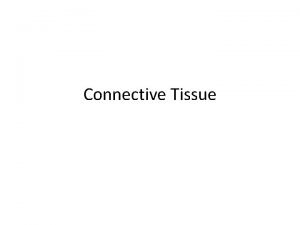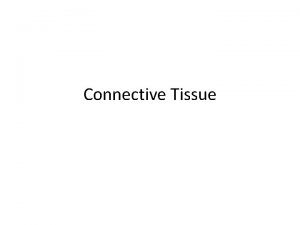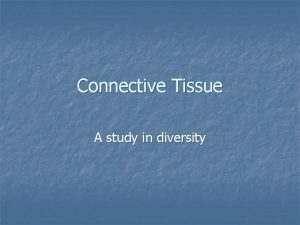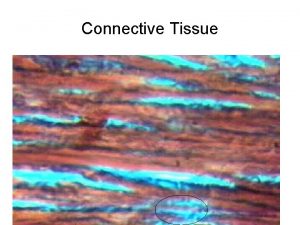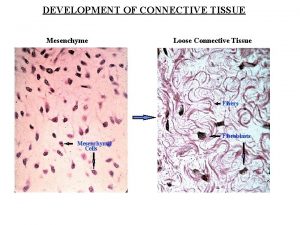Skin Dermis is the connective tissue which support
















- Slides: 16

Skin

Dermis is the connective tissue which support the epidermis, and bind it to the hypodermis (subcutaneous tissue). The thickness of the epidermis is varies according to the region of the body, reaching maximum thickness about 4 mm in the back

• Dermis contain two layers the outermost papillary layer and deeper reticular layer. • Papillary layer composed from loose connective tissue, fibroblast, mast cells, macrophage extravasated WBC can be seen. From this layer collagen fibrills insert into the basal lamina and extend into the dermis called (Anchoring fibrils)

• The reticular layer is thicker and composed from dense irregular connective tissue (type 1 collagen fibers), has more fibers and fewer cells than does the papillary layer.

• The elastin content of human skin increases approximately fivefold from fetal to adult life. In old age, extensive cross –linking of collagen fibers, the loss of elastic fibers, and degeneration of these fibers cause skin wrinkling. • In several disorders such as Ehlers Danlos syndrome, there is a considerable increase in skin and ligament extensibility caused by defective collagen –fibril processing.

• Subcutaneous tissue: • This tissue consist of loose connective tissue that bind the skin to the subjacent organs, it contain fat cells that vary in number and size according to the area of the body.

Vessels of the skin • The connective tissue of the skin has rich blood supply, the arterial vessels form two plexuses one located between the papillary and reticular layers, the outer between the dermis and the subcutaneous tissue. • Veins are disposed in three plexuses, two in the position similar to arterial plexuses, the third one in the middle of the dermis. • Arteriovenous anastamosis are present to regulate the body temperature

Skin receptors • Free nerve endings are sensitive to touch, tactile, high and low pressure, pain and itching. • Expanded nerve ending include (Ruffini ending), and the encapsulated ending include (Vater-Pacini, Meissner corpuscles), expanded and encapsulated receptors act as mechanoreceptors, Vater-Pacini and Ruffini endings are sensitive to movement of internal organs and pressure of one organ over another

Hairs • Hairs are elongated keratinized structures, their color, size vary according to race, age, sex and the region of the body. • Hairs are found everywhere in the body except in the palm, soles, lips, etc…. . . • Hairs grow discontinuously and have period of growth (anagen) followed by period of rest (catagen and telogen). • This growth does not occur synchronously in all regions of the body, it tend to occur in patches. • The duration of the growth and rest periods also varies according to the region of the body. • The growth period in areas such as scalp, face and pubis are strongly influenced by sex adrenal and thyroid hormones.

Nail • Nails are plates of keratinized epithelial cells. The proximal parts of the nail which is hidden by skin in the nail groove, is called the nail root. The stratum corneum of this skin forms the eponychium. The nail plate rest on a bed of epidermis called the nail bed. • The nearly transparent nail plate and the thin epithelium of the nail bed provide a useful window on the amount of oxygen in the blood by showing the color of blood in the dermal vessels.

Glands of the skin: • • • Sebaceous glands: These glands are embedded in the dermis they are found every where in the body but in the face, scalp and forehead they are presented in high frequency, and are not present in the palm and soles. The glands usually have short ducts that are end in the upper part on the hair follicle. The acini consist of a basal layer of undifferentiated epithelial cells that rest on the basal lamina, these cells proliferate and differentiate, filling the acini with rounded cells filled with fat droplets and burst, the product of this process is called sebum. Their nuclei gradually shrink. This gland is an example of holocrine gland, because its product is released with remnant of dead cells. The primary controlling factor of sebaceous gland secretion in men is testosterone; in women it is a combination of adrenal and ovarian androgens.

The flow of sebum is continuous, and a disturbance in the normal secretion and flow of sebum is one of the reasons for the development of acne, a chronic inflammation of obstructed sebaceous glands. It occurs mainly during puberty.

Acne

Sweat glands: • Sweat glands are widely distributed in the skin. • The merocrine sweat glands are simple, coiled, tubular glands whose ducts open at the skin surface. • Another type of sweat gland is the apocrine gland which is larger than merocrine sweat gland opened into the hair follicle. • The main components of fluid secreted by sweat gland are water, sodium chloride, urea, ammonia and uric acid. • The fluid is an ultra-filterate of the blood plasma. • Sweat glands act for cooling the surface and elimination of waste product.

• The secretory parts is surrounded by myoepithelial cells. • Two types of cells are present in the secretory part: • Dark cells are pyramidal cells, their basal surface does not touch the basal lamina secretory granules are abundant in their apical cytoplasm. • Clear cells are devoid from granules, their basal plasmalemma has numerous invaginations which is characteristic of ion transport. The ducts of these glands are lined by stratified cuboidal epithelium.

Thank you
 Seven functions of skin
Seven functions of skin Which letter indicates the dermis
Which letter indicates the dermis Narrow cavity in the dermis from which hair cells grow
Narrow cavity in the dermis from which hair cells grow Specialized connective tissues
Specialized connective tissues Nervous tissue description
Nervous tissue description Dense irregular connective tissue
Dense irregular connective tissue Cartilage hyaline function
Cartilage hyaline function Glassy membrane follicle
Glassy membrane follicle Regular connective tissue
Regular connective tissue Loose connective tissue cell types
Loose connective tissue cell types Identify the tissue.
Identify the tissue. The dominant fiber type in dense connective tissue is
The dominant fiber type in dense connective tissue is Lymphatic organ
Lymphatic organ Ground substance definition
Ground substance definition Fixed connective tissue
Fixed connective tissue Areolar vs reticular connective tissue
Areolar vs reticular connective tissue Serous mucous synovial and cutaneous membranes
Serous mucous synovial and cutaneous membranes
